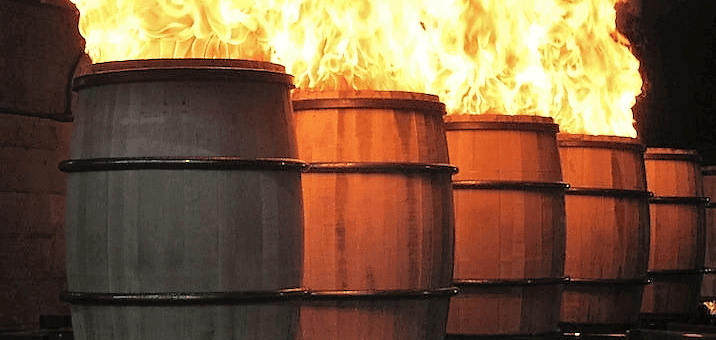The transformation of a harsh, clear spirit—often called "white dog" or moonshine—into a smooth, complex whiskey or a refined bourbon is a kind of magic. This magical process, known as maturation, relies on time, patience, and most importantly, the wooden barrel. But not all bourbon barrels are created equal.
The secret to unlocking specific flavors lies in how the barrel's interior is prepared. This is achieved by carefully applying fire, using two primary methods: charring and toasting. Understanding the difference between them is key to understanding the flavors in your glass.
Charred Barrels: The Secret to Sweetness and Smoothness
When a barrel is charred, it is subjected to an intense, open flame for a short period. This process essentially creates a layer of burnt, blackened wood on the inside of the barrel, often resembling the texture of alligator skin. This deep char has several profound effects on the aging spirit.
-
Sweet Flavors: The intense heat caramelizes the natural sugars within the wood. As the bourbon ages and interacts with the wood, these caramelized sugars are drawn out, imparting sweet and rich flavors like caramel, honey, and toffee into the final product.
-
Deep Color: The heavily burned interior gives the whiskey its characteristic deep amber and reddish-brown coloring.
-
Natural Filtration: The carbon layer created by the char acts as a natural filter. It works to remove harsher flavor compounds, like sulfurs, from the spirit, resulting in a smoother, mellower, and more approachable whiskey.
-
Scorch Levels: You may see barrels referred to with a "scorch level" (e.g., #1, #2, #3, or the very common #4). This number indicates the duration and intensity of the burn. A higher number, like a #4 "alligator char," means a deeper burn, which can create a more complex flavor profile and impart more color.
Toasted Barrels: Unlocking Spice and Vanilla
Unlike the intense fire of charring, toasting is a much gentler and slower process. Barrels are heated carefully, bringing the interior wood to a dark brown toast rather than a blackened char. This different heating method affects the wood's chemical compounds in a different way.
-
Spicy & Vanilla Flavors: Toasting breaks down the wood's lignin, releasing compounds that impart notes of vanilla and baking spices like clove and cinnamon. It also enhances the natural, oaky characteristics of the wood itself.
-
Sharper Taste: Because the wood sugars are not heavily caramelized, the resulting whiskey often has a sharper, spicier, and more wood-forward taste on the tongue compared to one aged in a charred barrel.
-
Lighter Color: Toasted barrels do not impart as much dark color into the spirit, typically resulting in a lighter, more golden hue.
Which Method is Better?
Ultimately, the choice between a charred or toasted barrel is a stylistic one made by the distiller to achieve a specific flavor profile. Neither method is inherently "better"—it all comes down to personal preference.
-
If you enjoy a smooth, rich, and sweet-tasting bourbon with notes of caramel and toffee, seek out whiskies aged in charred barrels. This is the standard for most American bourbons.
-
If, however, you appreciate a strong, spicy, and oak-forward beverage with prominent vanilla notes, a whiskey aged in toasted barrels would be more to your liking.
Some craft distillers even use barrels that are first toasted and then lightly charred, attempting to capture the best qualities of both methods. Understanding this fundamental step in the whiskey-making process can help you better identify the flavors you enjoy and choose the perfect bottle for your palate.
Sources:
American Distilling Institute
Whiskey industry publications (e.g., Whisky Advocate, The Bourbon Review)
Books on whiskey and bourbon production
Websites of major distilleries and independent cooperages (barrel makers)


